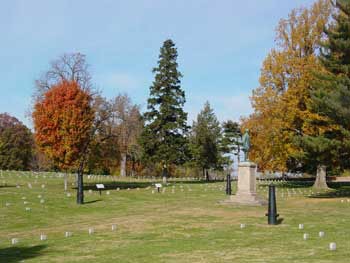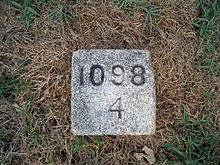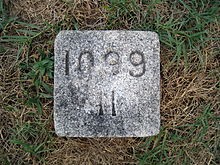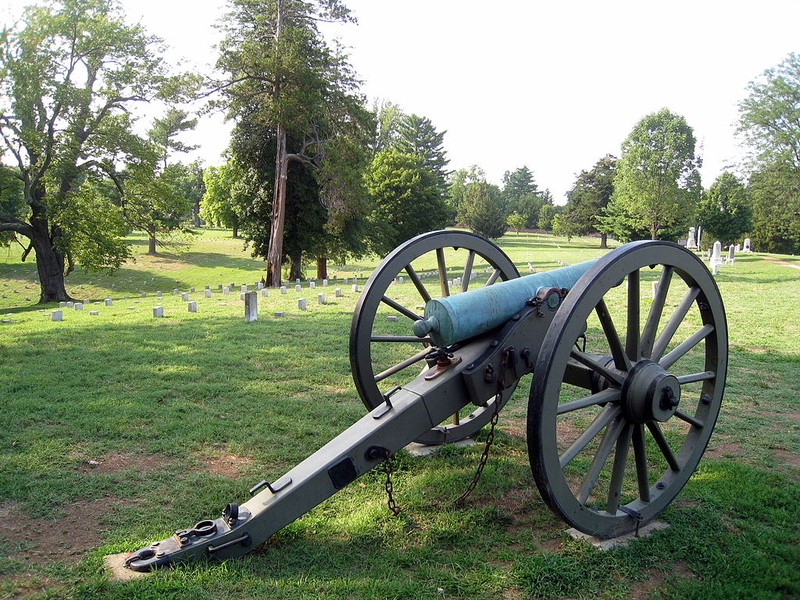This entry includes a walking tour! Take the tour.
Introduction
Text-to-speech Audio
Images
A section of the cemetery

Monument of the Union 5th Corps who charged the stone wall

Stone monument noting that 4 dead soldiers, unknown, are buried in this plot

Another noting 11 unknown soldiers are buried together in this plot

A cannon representing where Confederate General James Longstreet's cannon were located with his men in front along the stone wall. Headstones of the cemetery can be seen in the background. This section is called "Longstreet's Line."

Backstory and Context
Text-to-speech Audio
In 1865 the Civil War was over, but the United States faced perhaps the biggest disaster clean up in its history. Homes and cities in ruins, the economy suffering, and millions of soldiers to care for, both the living and the dead. Despite efforts to properly care for the dead during the war, most burials had not been organized well. Original efforts to take care of the dead in this area occurred in June 1865 when a party of men under Brevet Major James M. Moore searched the Wilderness and Spotsylvania, marking graves and consolidating the unburied into cemeteries on the battlefield. By June 24th they had buried almost 1500 skeletons, erecting 785 known headstones and many unknown ones over the graves. The job was far from complete, however, since they missed many of the bodies and the fields at Chancellorsville and Fredericksburg still needed attention.
In 1866 the War Department decided to consolidate the Union 15,000 burials contained by a 30 miles radius around Fredericksburg in one cemetery. This would include the scattered graves from as far north as Manassas, south as North Anna, east as Warsaw, and west as Mine Run. Originally, loyal citizens championed for the city Fairgrounds where many of the Union dead from the Battle of Fredericksburg were already buried. The planners found, however, that the water table was only three feet below the surface, making the area unsuitable for burials. Moore returned and suggested that the cemetery be placed on Willis Hill, the southern end of Marye’s Heights. Moore initially condemned eight acres of Douglas H. Gordon’s 23.5 acre lot on Willis Hill, later purchasing twelve acres of the land for $250 an acre. Meanwhile construction of the cemetery began in June 1866, more than two years before an official deed was signed for the land.
The work of the burial corps began in May 1866 by US soldiers stationed in Fredericksburg, but by June the government was paying former slaves, Irish Immigrants, and Confederate veterans $15 a month plus lodging and rations to do the work. Their camp was at the foot of Willis Hill, just across from where the visitor center stands today. It took until the fall of 1868 to finish the work of disinterring the dead from the battlefield, transferring them to the cemetery (which could be miles away, depending on the location of the burial), and reinterring them. The cemetery was not blocked out by state, unit, or battlefield; instead; bodies were buried as they came in to the cemetery.
Known burials represent a small percentage of the graves in the cemetery; just 2,643 burials (16.5%) are known and they are representing by the “Civil War type” headstones. 12,770 burials representing 83.5% of the men here, are unknown. Many of these men were buried hastily on the field or in mass graves with no way to identify the bodies later. For some of these men, their graves were originally marked or their bodies left with an identifier. For example, in 1939 W. M. Buckley donated to the park a small stone with the name “Dan” scratched on it. The stone was found beside a skeleton on the Chancellorsville battlefield, most likely as an identifier so friends could come back and locate the body. Unfortunately for “Dan” and thousands of other soldiers these identifiers were lost before they were buried and they now lie under “unknown” markers here in the cemetery. To aggravate matters many of the original wooden headstones were lost or taken for firewood.
The unknown markers you see today are the smaller square stones; the top number indicates the plot number while the bottom number is how many bodies are buried in that plot. There are anywhere between one and twelve bodies in each unknown grave. With the large number of unknown burials (7 out of every 8), the burial corps decided to save time and space by placing multiple bodies in a grave. Soldiers who are grouped together in these graves primarily came from the same locations on the field, and may have served in the same regiment or been buried together originally. Space was an issue in the parcel of land on Willis Hill; if each of the 15,436 burials had received an individual grave, they would have needed a cemetery plot of 30 acres. In addition to graves with multiple burials, the burial corps also terraced the front slope of Willis Hill to prevent erosion and provide for more flat space for graves.
Although the majority of Civil War soldiers were buried in the cemetery by 1868, the discovery of bodies and burials continued for decades afterwards. The last orderly internment of remains was in 1868; after that new burials were placed in different locations of the cemetery.
After the bodies of the Civil War dead were buried, the national cemeteries opened up to the burials of eligible veterans, their spouses, and dependent children. The last Civil War soldier buried in the National Cemetery was Private Evander Willis, who is buried with his wife, Lucy Sprague Willis. Evander enlisted in December 1863 in the 8th Vermont Infantry and was mustered out in 1865. After the war, the Willis family owned “Ellwood,” which is part of our Wilderness Battlefield. When Evander died in October 1935, he and his wife were buried here under a Civil War style stone.
In addition to Civil War soldiers, the cemetery has burials from the Spanish-American War, World War I, and World War II, as well as roughly twenty military spouses buried with their husbands. The last soldier buried in a separate grave was Harry Bankard in 1945. Bankard was not the last soldier buried here; that honor goes to Admol Jett who was buried four years later in the same plot as his father. The final burials in the cemetery would be the spouses of soldiers already buried here. The cemetery has been closed to new burials since the 1940s. Today if a soldier is found buried within the park, they are not reinterred into the National Cemetery. Instead their grave is marked and the remains not disturbed. You can find a few of these marked graves at Chatham and outside the Chancellorsville Visitor Center.
Cite This Entry
Thompson, Kathleen et. al. "Fredericksburg National Cemetery." Clio: Your Guide to History. May 25, 2021. Accessed April 14, 2025. https://theclio.com/entry/954
Sources
Pfanz, Donald C. "Where Valor Proudly Sleeps: A History of Fredericksburg National Cemetery, 1866-1933." National Park Service, 2007. (Available at Fredericksburg & Spotsylvania NMP)

